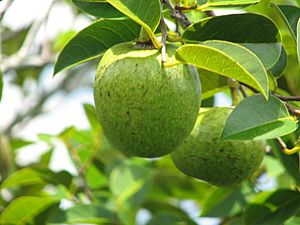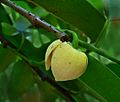Pond-apple facts for kids
Quick facts for kids Pond-apple |
|
|---|---|
 |
|
| Pond-apple foliage | |
| Scientific classification | |
| Kingdom: | |
| Division: | |
| Class: | |
| Order: | |
| Family: | |
| Genus: | |
| Species: |
A. glabra
|
| Binomial name | |
| Annona glabra |
|
The pond-apple is a type of fruit that grows on a tree. It is not related to the common apple you might eat. These trees usually live near or in water, which is how they got their name. Pond-apples are known for their unique fruit and their ability to grow in wet, swampy areas.
Contents
What is a Pond-Apple?
A pond-apple is a tree that can grow up to 40 feet (12 meters) tall. It belongs to the Annonaceae family, which also includes other well-known fruits like the soursop and custard apple. The tree has smooth, gray bark and large, shiny green leaves.
Where Does it Grow?
Pond-apple trees are native to tropical and subtropical regions. You can find them naturally in places like Florida in the United States, parts of Central and South America, and West Africa. They love warm climates and lots of moisture. Because they need so much water, they often grow along riverbanks, in swamps, or near ponds.
What Does it Look Like?
The pond-apple tree has pretty flowers that are pale yellow or greenish-white. These flowers have a strong, sweet smell. The fruit itself is round or oval-shaped and can be up to 6 inches (15 cm) long. When it's ripe, the skin turns yellow or orange. Inside, the fruit has a soft, creamy pulp with many dark brown seeds.
The Pond-Apple Fruit
The fruit of the pond-apple tree is quite interesting. It's often described as looking a bit like a lumpy green or yellow apple.
Can You Eat It?
Yes, you can eat the pond-apple fruit. However, its taste can vary a lot. Some people find it sweet and pleasant, while others describe it as bland or even unpleasant. It's often eaten by wildlife, like alligators and raccoons, in its native habitats. Humans sometimes use it in jams, jellies, or drinks.
Other Uses
Besides its fruit, the pond-apple tree has other uses. Its wood is light and soft, so it's not typically used for building. However, some parts of the tree have been used in traditional medicine in certain cultures. The tree's ability to grow in wet areas also makes it useful for stabilizing soil and preventing erosion along waterways.
Pond-Apple and Water
The pond-apple tree is perfectly adapted to living in very wet conditions. Its roots can handle being submerged in water for long periods.
Why it Loves Water
The tree has special roots that help it breathe even when the soil is waterlogged. This adaptation allows it to thrive in places where most other trees would struggle to survive. It often forms dense thickets in swampy areas, providing habitat for various animals.
Is it Invasive?
While native to some areas, the pond-apple can become an invasive species in other parts of the world. For example, in places like Sri Lanka, it has been introduced and has spread rapidly, outcompeting native plants. This can harm the local ecosystem by reducing biodiversity. When a plant is invasive, it means it grows so well that it takes over from plants that naturally belong there.
Images for kids
See also

- In Spanish: Bagá de Cuba para niños




